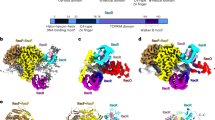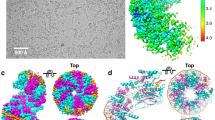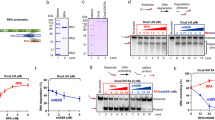Abstract
The RecA protein of Escherichia coli is involved in recombination (for review see ref. 1). The protein binds transiently to double-stranded DNA in the presence of ATP. In the presence of ATPγS, a non-hydrolysable analogue of ATP, rec A–DNA complexes are stable2,3. Duplex DNA in these complexes is stretched by a factor 1.5 (ref. 4), and the complexes appear in the electron microscope as helical filaments with a pitch of ∼100 Å and 6.2 recA units per turn covering 18.6 base pairs (bp)5. RecA crystals have a space group of similar helical parameters6. In order to understand the function of recA, it is necessary to describe the conformation of the DNA in the recA complex. Using a topological method, the present work determines the helicity of DNA in the complex. We find that the DNA helix follows the protein helix visible in the electron microscope and has 18.6 bp per turn, which corresponds to an unwinding of the DNA double helix by 15° per bp.
This is a preview of subscription content, access via your institution
Access options
Subscribe to this journal
Receive 51 print issues and online access
$199.00 per year
only $3.90 per issue
Buy this article
- Purchase on Springer Link
- Instant access to full article PDF
Prices may be subject to local taxes which are calculated during checkout
Similar content being viewed by others
References
Radding, C. M. Cell 25, 3–4 (1981).
McEntee, K., Weinstock, G. M. & Lehman, I. R. J. biol. Chem. 256, 8835–8841 (1981).
West, S. C., Cassuto, E., Mursalim, J. & Howard-Flanders, P. Proc. natn. Acad. Sci. U.S.A. 77, 2569–2573 (1980).
Stasiak, A., Di Capua, E. & Koller, Th. J. molec. Biol. 151, 557–564 (1981).
Di Capua, E., Engel, A., Stasiak, A. & Koller, Th. J. molec. Biol. 157, 87–103 (1982).
McKay, D. B., Steitz, T. A., Weber, I. T., West, S. C. & Howard-Flanders, P. J. biol. Chem. 255, 6662 (1980).
Cunningham, R. P., Shibata, T., Das Gupta, C. & Radding, C. M. Nature 281, 191–195 (1979).
Crick, F. H. C. Proc. natn. Acad. Sci. U.S.A. 73, 2639–2643 (1976).
Keller, W. Proc. natn. Acad. Sci. U.S.A. 72, 4876–4880 (1975).
Wang, J. C. Proc. natn. Acad. Sci. U.S.A. 76, 200–203 (1979).
Rhodes, D. & Klug, A. Nature 286, 573–578 (1980).
Baase, W. A. & Johnson, W. C. Jr Nucleic Acids Res. 6, 797–814 (1979).
Champoux, J. J. & McConaughy, B. L. Biochemistry 15, 4638–4632 (1976).
Author information
Authors and Affiliations
Rights and permissions
About this article
Cite this article
Stasiak, A., Di Capua, E. The helicity of DNA in complexes with RecA protein. Nature 299, 185–186 (1982). https://doi.org/10.1038/299185a0
Received:
Accepted:
Issue Date:
DOI: https://doi.org/10.1038/299185a0
This article is cited by
-
Understanding the physics of DNA using nanoscale single-molecule manipulation
Frontiers of Physics (2012)
-
DNA stretching by bacterial initiators promotes replication origin opening
Nature (2011)
-
Mechanism of homologous recombination from the RecA–ssDNA/dsDNA structures
Nature (2008)
-
Physicochemical Basis of RecA Filamentation on Single-Stranded DNA
Molecular Biology (2005)
-
A tale of two polymers: new insights into helical filaments
Nature Reviews Molecular Cell Biology (2003)
Comments
By submitting a comment you agree to abide by our Terms and Community Guidelines. If you find something abusive or that does not comply with our terms or guidelines please flag it as inappropriate.



